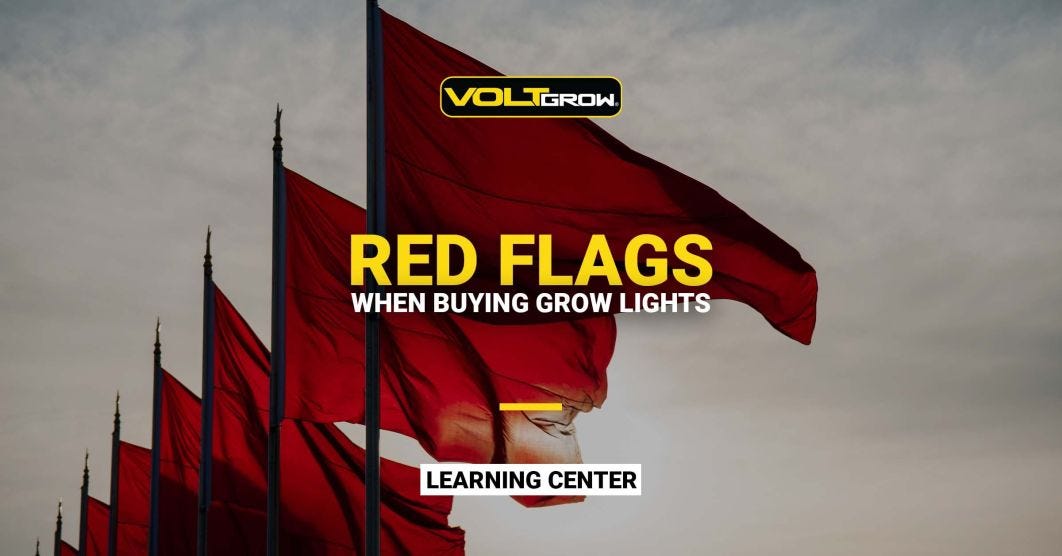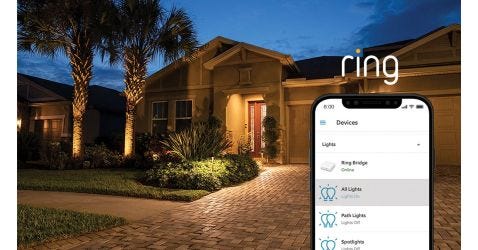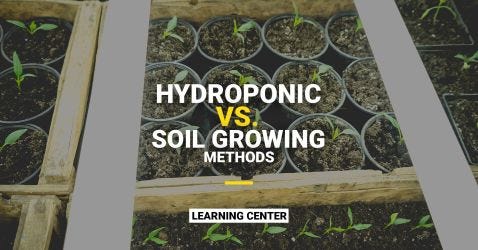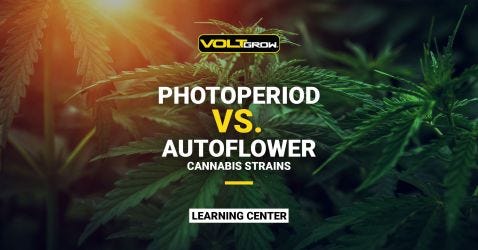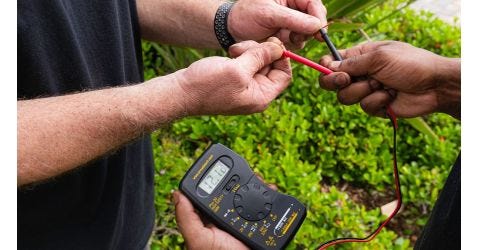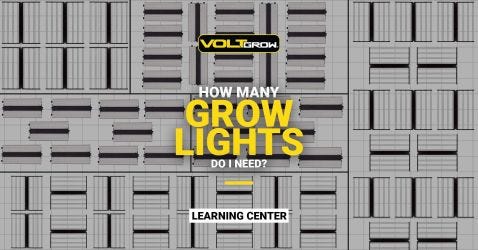Don’t let false marketing fool you when shopping for LED grow lights. Here are some red flags to look out for to ensure you are making a quality purchase from a credible company.
Irrelevant Specs
Many companies market certain specs that might look impressive but are actually misleading and irrelevant to grow lights’ performance.
- For example, although wattage is important in knowing how much power the light uses, it does not tell you anything about how much useable light it outputs. Particularly deceptive companies will have outrageously high wattages in the product names and then bury the “true wattage” deep in the description. Even reputable companies advertise their light having a very high wattage consumption, but it is important to look at the light’s efficacy — which is how efficiently the light converts that power into light. Looking at metrics like PPF (µmol/s) and efficacy (µmol/J) are the best, especially if the data is being provided by an independent source like the DLC Horticulture Qualified Products List.
- Many manufacturers advertise the color temperature (Kelvin) of a grow light when advertising, however, Kelvin only measures how light looks to the human eye— i.e. whether it has a warmer or cooler color to it. Kelvin does not accurately describe the spectrum distribution of the light, which is what actually affects plant growth. While it can be used to get an idea if a light produces more red or blue light, the most accurate method is looking at a spectrum distribution chart that shows the relative amount of each part of the light spectrum being produced.
- Similarly, lumens only measure the brightness of light as seen by humans and do not reflect how powerful the light will be for growing plants. There are only specific wavelengths of light that contribute to photosynthesis in plants, known as Photosynthetically Active Radiation (i.e. PAR). The amount of PAR produced is represented in grow light spec sheets by PPF, which is much more important to consider when evaluating how powerful a grow light is. Manufacturers are notorious for boasting lumen outputs, which don’t actually indicate the amount of usable light that is being produced.
No Warranty
Grow lights are an investment, which is why it is important to make sure the company you are buying from offers a warranty in case your light is defective when delivered and after long-term use. Issues sometimes occur with LED grow lights, especially in the demanding circumstances of a grow room. Any company that is reputable and confident in their products’ quality and performance will offer at least a 3-Year warranty. A lack of warranty is a tell-tale for a lack of credibility from the company. VOLT Grow® LED grow lights have an extensive 5-year warranty.
Shipping Directly From Overseas
When companies are based overseas, this can lead to a number of problems. It is very hard to ensure quality control if manufacturers are drop-shipping from overseas and not integrated within a reputable company. Also, lack of domestic inventory usually means very long lead times to receive lights. This is very problematic if there is an issue with your light in the middle of a growth cycle and you need to get a replacement shipped to you ASAP. If there is an issue with a light, the lack of readily available products in the USA can severely impact your growth and leave you without functioning lights for months.
No Third-Party Certifications or Listings
Certifications from either ETL or UL (c-UL for Canada) are an absolute necessity before buying a grow light. These organizations are responsible for testing any electronic device to ensure it was built with proper safety standards. Installing a light, or any electronic for that matter, that wasn’t approved by a certified organization can void insurance claims if there is an accident like an electrical fire. It can also violate electrical codes in the USA and Canada, making it against the rules to use for non-residential applications and can violate contracts signed with leased buildings.
A company not having any third-party testing on their specifications is worrying for grow lights, as there are many false claims about performance made by less scrupulous companies. In order to trust a light’s specs are accurate, look for independent testing data or ideally a DLC listing. The DLC is the organization that tests the efficiency of grow lights and they independently test grow lights before approving them to ensure they meet their efficiency standards. The DLC publishes all of its testing data on the DLC Horticulture Qualified Products List.
No Reviews
Happy customers are the best advocates, so if a product is lacking positive reviews or any reviews at all, that is a major red flag. Numerous high-rated customer reviews prove that what you see online is confirmed by real-life performance. Reviews are not only important when evaluating the quality of the product, but also the legitimacy of the company as a whole. The reviews will not only talk about the light’s performance, but also the company’s customer service, shipping times, etc. Be wary of short, non-specific overwhelmingly positive reviews, as many companies will create fraudulent reviews of their own products. Ideally, look for reviews from third-party verified purchasers like Google Customer Reviews.
Not Full-Spectrum (Colored Diodes)
Blue and red colored lights (also known as “blurple” or “smurf” lights) were the first LEDs on the market, but since further advancements, they have been proven inferior and outdated. Full-spectrum light is the ideal spectrum of light for plants since it most closely mimics the natural spectrum of the sun. These plants evolved for thousands of years to take advantage of natural sunlight, so replicating that will result in healthier and happier plants. Full-spectrum lights include all colors (wavelengths) of light because each color— not just red and blue— contributes to a different aspect of the plant’s growth. Avoid the outdated, cheaper fixtures that are not full-spectrum, as they can have negative effects on a plant’s morphology and general health.
Promising Specific Yields
Any company that promises an increase in yield with their light, or a guaranteed yield, is not being entirely honest with their customers. Knowledgeable growers understand that lighting is only one of many factors that affect growth, and light alone cannot determine yield. The results will depend on the strain, growing method, nutrients used, watering, temperature and humidity levels, CO2 implementation, and much more. Of course, increasing your light density will give you the potential to increase your yields, but only when done in conjunction with providing proper nutrients, environmental controls, etc. A company that makes promises guaranteeing specific high yields by switching lights alone demonstrates a lack of understanding of growing and is not being transparent with customers.

